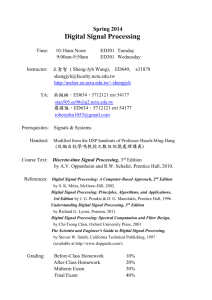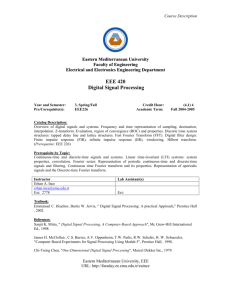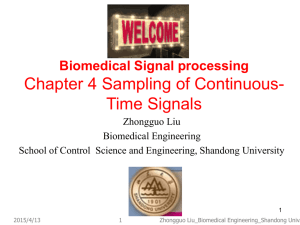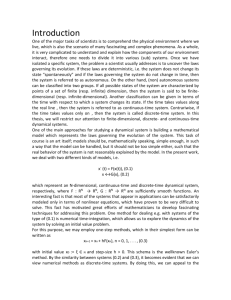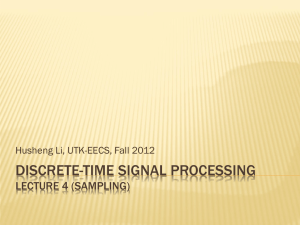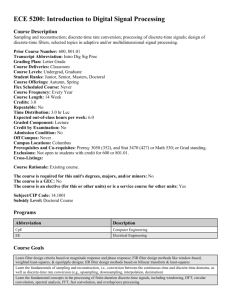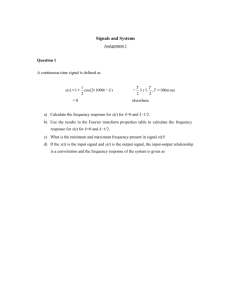Formalizing Causal Block Diagrams for Modeling a Class of
advertisement
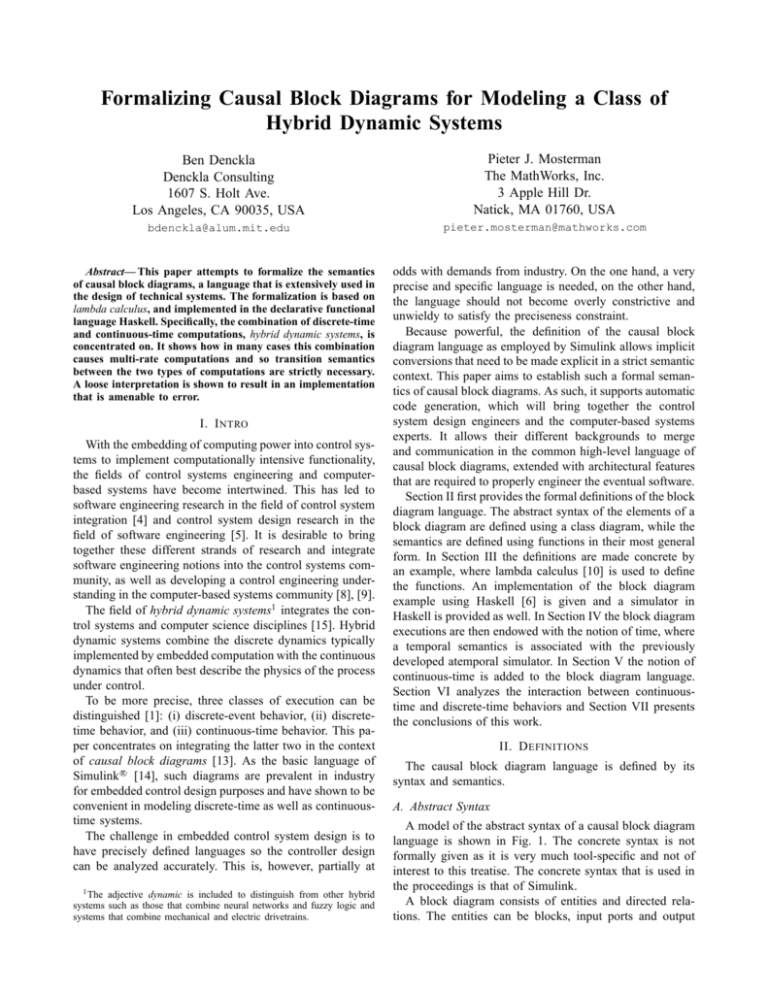
Formalizing Causal Block Diagrams for Modeling a Class of
Hybrid Dynamic Systems
Ben Denckla
Denckla Consulting
1607 S. Holt Ave.
Los Angeles, CA 90035, USA
Pieter J. Mosterman
The MathWorks, Inc.
3 Apple Hill Dr.
Natick, MA 01760, USA
bdenckla@alum.mit.edu
pieter.mosterman@mathworks.com
Abstract— This paper attempts to formalize the semantics
of causal block diagrams, a language that is extensively used in
the design of technical systems. The formalization is based on
lambda calculus, and implemented in the declarative functional
language Haskell. Specifically, the combination of discrete-time
and continuous-time computations, hybrid dynamic systems, is
concentrated on. It shows how in many cases this combination
causes multi-rate computations and so transition semantics
between the two types of computations are strictly necessary.
A loose interpretation is shown to result in an implementation
that is amenable to error.
I. I NTRO
With the embedding of computing power into control systems to implement computationally intensive functionality,
the fields of control systems engineering and computerbased systems have become intertwined. This has led to
software engineering research in the field of control system
integration [4] and control system design research in the
field of software engineering [5]. It is desirable to bring
together these different strands of research and integrate
software engineering notions into the control systems community, as well as developing a control engineering understanding in the computer-based systems community [8], [9].
The field of hybrid dynamic systems1 integrates the control systems and computer science disciplines [15]. Hybrid
dynamic systems combine the discrete dynamics typically
implemented by embedded computation with the continuous
dynamics that often best describe the physics of the process
under control.
To be more precise, three classes of execution can be
distinguished [1]: (i) discrete-event behavior, (ii) discretetime behavior, and (iii) continuous-time behavior. This paper concentrates on integrating the latter two in the context
of causal block diagrams [13]. As the basic language of
R
Simulink
[14], such diagrams are prevalent in industry
for embedded control design purposes and have shown to be
convenient in modeling discrete-time as well as continuoustime systems.
The challenge in embedded control system design is to
have precisely defined languages so the controller design
can be analyzed accurately. This is, however, partially at
1 The adjective dynamic is included to distinguish from other hybrid
systems such as those that combine neural networks and fuzzy logic and
systems that combine mechanical and electric drivetrains.
odds with demands from industry. On the one hand, a very
precise and specific language is needed, on the other hand,
the language should not become overly constrictive and
unwieldy to satisfy the preciseness constraint.
Because powerful, the definition of the causal block
diagram language as employed by Simulink allows implicit
conversions that need to be made explicit in a strict semantic
context. This paper aims to establish such a formal semantics of causal block diagrams. As such, it supports automatic
code generation, which will bring together the control
system design engineers and the computer-based systems
experts. It allows their different backgrounds to merge
and communication in the common high-level language of
causal block diagrams, extended with architectural features
that are required to properly engineer the eventual software.
Section II first provides the formal definitions of the block
diagram language. The abstract syntax of the elements of a
block diagram are defined using a class diagram, while the
semantics are defined using functions in their most general
form. In Section III the definitions are made concrete by
an example, where lambda calculus [10] is used to define
the functions. An implementation of the block diagram
example using Haskell [6] is given and a simulator in
Haskell is provided as well. In Section IV the block diagram
executions are then endowed with the notion of time, where
a temporal semantics is associated with the previously
developed atemporal simulator. In Section V the notion of
continuous-time is added to the block diagram language.
Section VI analyzes the interaction between continuoustime and discrete-time behaviors and Section VII presents
the conclusions of this work.
II. D EFINITIONS
The causal block diagram language is defined by its
syntax and semantics.
A. Abstract Syntax
A model of the abstract syntax of a causal block diagram
language is shown in Fig. 1. The concrete syntax is not
formally given as it is very much tool-specific and not of
interest to this treatise. The concrete syntax that is used in
the proceedings is that of Simulink.
A block diagram consists of entities and directed relations. The entities can be blocks, input ports and output
Entity
Port
InputPort
0..1
Relation
0..*
Block
0..1
0..*
OutputPort
Fig. 1.
Model of the abstract syntax of a block diagram.
ports. Relations are directed and connected to input ports
and output ports. An input port can only be the destination
of a relation, whereas an output port can only be the source
of a relation.
Input ports and output ports can be bound to exactly one
block or no block at all, indicated by the 0..1 cardinality.
In turn, each block can have zero or an arbitrary number of
input and output ports bound to it (0..* cardinality).
The block is the basis for each block diagram. It can
be connected to other blocks by its input and output ports.
Input and output ports that are not associated with a block
represent input and output that is external to the block
diagram.
B. Static Semantics
To define the semantics of the block diagram language,
a mathematical representation is given for each of the
concrete entities in the abstract syntax: Block, InputPort,
OutputPort, and Relation. Note that, though the function domains will be defined to be the complex values,
the domains can be arbitrarily chosen. Instead of numerical
values, symbols could be chosen as well. This notion is not
further discussed in this paper.
1) Block: A Block can have InputPorts and
OutputPorts associated with it. Each InputPort is bound
to a variable ui , i ∈ [1..l] that is considered input to the
Block, and each OutputPort is bound to a variable yj ,
j ∈ [1..m] that is considered output of the Block. In
addition, a Block binds variables xk and zk , k ∈ [1..n] to
non-visible input and output that connects to the execution
engine.
The behavior of a Block is defined by a function, f ,
that maps the space of explicit input, U , and the space of
implicit input, X, onto the space of explicit output, Y , and
the space of implicit output, Z.
Definition 1 (Block): A Block is a tuple hU, X, Y, Z, f i
with f : U × X → Y × Z, and U ∈ (< × =)l , X, Z ∈
(< × =)n , and Y ∈ (< × =)m , where l, m, n ∈ ℵ.
2) InputPort: An InputPort that is not associated with
a Block binds an external output variable, υj , to an explicit
output variable, yj , j ∈ [1..m].
Definition 2 (InputPort): An unbound InputPort is a
pair hΥ, Y i with (∀j ∈ [1..m]|υj = yj ), and Υ, Y ∈ (< ×
=)m , and m ∈ ℵ.
3) OutputPort: An OutputPort that is not associated
with a Block binds an external input variable, ψj , to an
explicit input variable, ui , i ∈ [1..l].
Definition 3 (OutputPort): An unbound OutputPort is
a pair hU, Ψi with (∀i ∈ [1..l]|ui = ψi ), and U, Ψ ∈ (< ×
=)l , and l ∈ ℵ.
4) Relation: A Relation binds an explicit output variable, yi , to an explicit input variable, ui , with i ∈ [1..p] and
p ≤ m ∧ p ≤ n.
Definition 4 (Relation): A Relation is a pair hU, Y i
with (∀i ∈ [1..p]|ui = yi ), and U, Y ∈ (< × =)p , and
p ∈ ℵ.
C. Block Diagram
The entire block diagram can then be defined as a
function that operates on the external and implicit input
to the block diagram and returns the external and implicit
output of the block diagram.
Definition 5 (Block Diagram): A BlockDiagram is a
tuple hΥ, X, Ψ, Z, φi with φ : Υ × X → Ψ × Z and
Υ ∈ (< × =)m , X, Z ∈ (< × =)n , Ψ ∈ (< × =)l , and
l, m, n ∈ ℵ
Note that the definition of the static semantics of a
block diagram coincides with the definition of a block
(Definition 1) and so a block diagram can be considered
a block in its own right. This allows for a hierarchical
decomposition of blocks into block diagrams, but this notion
is beyond the scope of this paper.
D. Execution Manager
An ExecutionManager repeatedly executes the block
diagram function, φ, and assigns it an interpretation as
an evolving behavior. The execution manager provides the
external and implicit input to the block diagram and obtains
the external and implicit output of the block diagram. In its
most general form, this behavior is an iteration that modifies
the output of φ at each iteration to produce a new input to
φ. The new input to φ is computed by a function θ.
Definition 6 (Execution Manager): The
ExecutionManager consist of a function θ : Ψ × Z →
Υ × X that is repeatedly applied and includes a block
diagram function φ : Υ × X → Ψ × Z.
In discrete-time execution, the function θ typically assigns
zi to xi , i.e., (∀i ∈ [1..l])(xi = zi ), to compute the new
input to φ:
hψ, zi = φ(υ, x)
(1)
θ:
x=z
where υ ∈ Υ, ψ ∈ Ψ, x ∈ X, and z ∈ Z and m = l.
The repeated execution of θ results in a trajectory or
behavior of the block diagram output.
Definition 7 (Behavior): A behavior is a sequence of
pairs hΥ, Xii with i ∈ [1..µ] and µ ∈ ℵ.
III. A H ASKELL I MPLEMENTATION
A block diagram simulator defines the block diagram as
well as the execution manager using the functional language
Haskell [6]. Note that in related work, Haskell is used to
define noncausal models [11].
A. An Example
To make the definitions and their elements in Section II
concrete, consider the block diagram in Fig. 2. This block
diagram consists of a Constant block and an input port,
In, that are connected to a Sum block. The Sum block
connects to a Delay block. The Delay block connects to
both a Scope and output port, Out, which illustrates the
destination cardinality of relations being more than 1.
1
1
Rel2
1
In
1
Out
Rel0
Constant
Sum
Rel1
z
Rel3
Delay
s = (f toplevel, x0 toplevel)
where
-- Subsystem construction
-- e.g. (f System, x0 System) = c SystemConstructor p x0
(f Constant, x0 Constant) = c Constant 1
(f Delay, x0 Delay) = c UnitDelay 1
(f Scope, x0 Scope) = c Recorder
f Sum = c AddAdd
Scope
Fig. 2.
A block diagram example.
In terms of the abstract syntax, this block diagram
consists of four Blocks (Constant, Sum, Delay, Scope), four
OutputPorts (one free one called In, and one associated
with each of the Constant, Sum, and Delay blocks), five
InputPorts (one free one called Out, two associated with
the Sum block, and one associated with each of the Delay
and Scope blocks), and five Relations. There are three
relations with destination cardinality one, marked Rel0
through Rel2, while there is one relation with destination
cardinality two, marked Rel3.
To execute this block diagram, each of the blocks has to
be defined in terms of a function that allows lazy evaluation.
Lazy evaluation (as opposed to strict evaluation) allows a
function evaluation without all the input arguments being
available. This matches blocks in causal block diagrams
perfectly, as it may be beneficial to evaluate the one
function that captures the semantics of a block in multiple
stages. For example, in Simulink one block is defined by
multiple functions such as mdlOutputs and mdlUpdate that
are evaluated strictly [3], [7].
B. The Block Diagram Function
Because of its declarative nature and lazy evaluation,
in this work, lambda calculus [10] is used to capture
the semantics of each of the blocks. Haskell is mostly a
syntactic sophistication of the lambda calculus.
The definitions of the block constructors for the block
diagram in Fig. 2 are
c
c
c
c
λx.y in the lambda calculus. For example, the function
for the Delay block shows two arguments, the state x
and the input u. The function body appears after the ->
operator and for Delay, it shows how it returns the state
as new output and the input as the new state (the ordering
of the x and u pair is reversed). The Constant function
operates similarly, except that it does not update its state.
The Recorder function shows how it adds the input u to
the list of stored values x. Addition is defined as the Haskell
function ‘+’ in its ‘uncurried’ form, i.e., it takes one pair
as an argument instead of two separate values.
The Haskell code that is generated for the block diagram
in Fig. 2 is straightforward:
AddAdd = uncurry (+)
UnitDelay x0 = (\x u -> (u, x), x0)
Constant c = (\x -> (x, x), c)
Recorder = (\x u -> x ++ [u], [])
The Haskell expression \x -> y is an unnamed function
with formal argument x and body y. It is analogous to
-- Initial state computation and state advance function
x0 toplevel = (x0 Constant, x0 Delay, x0 Scope)
f toplevel (x Constant, x Delay, x Scope) y In =
((xp Constant, xp Delay, xp Scope), u Out)
where
-- Connections between ports
-- e.g. u System1 inport = y System2 outport
u Delay input = y Sum output
u Scope input = y Delay output
u Sum input1 = y Constant output
u Sum input2 = y In
u Out = y Delay output
-- Bindings of ports to functions
-- e.g. y System outport = f System u System inport
(xp Constant, y Constant output) =
f Constant x Constant
(xp Delay, y Delay output) =
f Delay x Delay u Delay input
xp Scope = f Scope x Scope u Scope input
y Sum output = f Sum (u Sum input1, u Sum input2)
C. The Execution Manager
The execution manager is also implemented in Haskell:
execManager (f,x) []
= (x,[])
execManager (f,x) (u:us)= (xFinal,(x,y):restOfXYPairs)
where
(xp,y) = f x u
(xFinal,restOfXYPairs) = execManager (f,xp) us
The first line (base case of the recursion) says: if any
system is run on an empty input sequence [], return the
initial state as the final state and an empty sequence of
external output and implicit output pairs. The second and
following lines generate the trajectory. When applied to an
input sequence of length n, execManager, returns a pair
of the final (n + 1)th state and the sequence of external
output (in the implementation description y) and implicit
output (in the implementation description x, also referred
to as state) pairs for all previous n:
(x(n), [(x(0),y(0)), (x(1),y(1)), ... , (x(n-1),y(n-1))])
where the elipses indicate the pairs between 1 and n − 1
(n ≥ 4).
An example use is:
V. C ONTINOUS -T IME S YSTEMS
execManager (\x u -> (u,2*x), 9) [1,3,7]
which returns
(7,[(9,18),(1,2),(3,6)])
So, running a system of a delay with output scaled by
two and initial state 9 on the input sequence [1,3,7] gives
final state 7, outputs [18,2,6], and evolves through the
intermediate states [9,1,3].
The execution manager can now be used to execute the
block diagram in Fig. 2. The input sequence [3,5,9] is
applied by the command
execManager exampleBlockDiagram [3,5,9]
The result of this execution is
(
(1,10,[1,4,6]),
[
((1, 1,[ ]),1),
((1, 4,[1 ]),4),
((1, 6,[1, 4]),6)
]
)
This
output
has
the
form
(finalState,
listOfStateAndOutputPairs), which in this case
is
(
x(3),
[
(x(0), y(0)),
(x(1), y(1)),
(x(2), y(2))
]
)
where the state, x has the form (ConstantState,
DelayState, RecorderState). The final output
(1,10,[1,4,6]) then corresponds to (ConstantState
= 1, DelayState = 10, RecorderState =
[1,4,6]), as expected. Note that the Delay has an
initial state value of 1.
IV. T IME
IN
S INGLE -R ATE E XECUTION
So far, the block diagram execution as obtained by the
execution manager in Definition 6 is atemporal. It is a
repeated application of θ. Time has not been part of the
definitions as the block diagram was assumed to be of
single rate. All states advanced simultaneously, and so a
bare sequence of states ensues.
For the single rate block diagram models, a straightforward temporal interpretation is allowed by assuming
periodicity of evaluations. In other words, there is a constant
interval of time, h = ti+1 −ti , between each of the repeated
evaluations θ. To implement this, the execution can be
redefined as a repeated application of {θ(ψ, z, ti ) ◦ (ti+1 =
ti +h)}. The sequence of tuples that comprise the trajectory
in Definition 7 are then equally spaced in time.
Definition 8 (Temporal Behavior): A temporal behavior
is a sequence of triples hΥ, X, tii with i ∈ [1..µ], ti+1 −ti =
h and µ ∈ ℵ and h ∈ <.
While embedded controller models are well captured
by execution in discrete-time, plant models are typically
designed using ordinary differential equations (ODE) or
differential and algebraic equations (DAE) [2]. This requires
the execution to handle continuous-time behavior evolution.
A. Representing Continuous-Time
The Integrator block in a block diagram represents
continuous states and
R t models the time-integration operation
x(ti+1 ) = x(ti ) + tii+1 u(t)dt, with u(t) the input to the
Integrator. The output, y(ti ), of the Integrator at time
ti equals the stored state, x(ti ), at that point in time.
Numerical simulation of continuous-time systems typically proceeds by computing a finite number of points on
the continuous curve. This results in a representation that is
discretized in time. There are, however, some critical differences between discrete-time and continuous-time blocks. In
particular, the new state computation in discrete-time can be
a trivial mapping xi (ti+1 ) = zi (ti ) whereas in continuoustime the state at the next point in time, x(ti+1 ), has to be
inferred from its gradient in time at one or more preceding
points in time, ẋ(ti ), ẋ(ti−1 ), . . . , ẋ(t0 ), with t0 the initial
time at which execution of the block diagram starts.
This inferencing scheme is often referred to as the
numerical solver, or solver for short, and the algorithm it
implements can be quite elaborate [12]. What sets apart
continuous-time and discrete-time in this context are the
continuity constraints of the continuous-time trace that
the solver employs. For example, if the solver is based
on a Runge-Kutta fourth order algorithm, it assumes the
continous time trace has well-defined time-derivatives up
till the fourth order, i.e., the signal is C 4 . This assumption
then translates into the type of curve that is being fit between
the computed points.
In the definition of a block diagram in Section II, the
computations performed by the solver are executed in the
function θ, which, therefore, can become quite complex.
An additional assumption that now is required is that the
variables involved in a block diagram are complex. In
addition, any restriction that the solver requires, such as the
function it integrates being Lipschitz and having a certain
continuity, carry over as a requirement on the block diagram
formulation.
B. Computing Continuous-Time Trajectories
The most straightforward integration scheme is a forward
Euler, which multiplies the time-derivative, ẋ(ti ), at a time
ti by the step size, h = ti+1 − ti , and adds this to the
current state, x(ti ), to produce the state at ti+1 as x(ti+1 ) =
hẋ(ti ) + x(ti ).
The forward Euler can be used to transform a hybrid
dynamic system to a completely discrete representation.
However, because of its simplicity, this approach can give
a false sense of appopriately dealing with continuoustime systems. Therefore, in this work a more advanced
second order Runge-Kutta algorithm is implemented. The
integration equations are
m1 = hφ(x(ti ), ti )
m2 = hφ(x(ti ) + 0.5m1 , ti + 0.5h)
x(ti+1 ) = x(ti ) + m2
(2)
The function θ in Definition 6 is then straighforward to
derive as
hψ(ti ), z(ti )i = φ(υ(ti ), x(ti ), ti )
m1 = hz(ti )
hψ(ti + 0.5h), z(ti + 0.5h)i =
(3)
θ:
φ(υ(ti + 0.5h), x(ti ) + 0.5m1 , ti + 0.5h)
m2 = hz(ti + 0.5h)
x(ti+1 ) = x(ti ) + m2
where υ ∈ Υ, ψ ∈ Ψ, x ∈ X, z ∈ Z, and m1 and m2 with
the same dimension as x.
Note that computationally, this is still a single-rate system, where the time interval between each consecutive pair
of computations is 0.5h. However, the υ, x, and z values
that are computed at each ti + 0.5h in Eq. (3), also referred
to as minor time steps [14], are not stored.
VI. H YBRID DYNAMIC S YSTEMS
To operate on a block diagram with mixed discrete-time
and continous-time states, the block diagram definition is
first extended to distinguish between continuous-time states,
Xc , and discrete-time states, Xd , with X ≡ Xc ∪ Xd and
Xc ∩ Xd ≡ ∅. This definition applies similarly to the Z
space.
Definition 9 (Hybrid Block Diagram): The
HybridBlockDiagram is a tuple hΥ, Xc , Xd , Ψ, Zc , Zd , φi
with φ : Υ × Xc × Xd → Ψ × Zc × Zd and
Υ ∈ (< × =)m , X ≡ Xc ∪ Xd ∈ (< × =)n , Ψ ∈ (< × =)l ,
Z ≡ Zc ∪ Zd ∈ (< × =)n , and l, m, n ∈ ℵ.
A. A Loose Implementation
In a straightforward implementation, it is tempting to
simply combine the θ function of the continuous-time and
single-rate discrete-time executions. In this approach, the
combination of the second order Runge-Kutta integration
scheme and and the discrete-time state update yields
hψ(ti ), zc(ti ), zd(ti )i = φ(υ(ti ), xc(ti ), xd(ti ), ti )
m1 = h · zc
hψ(ti + 0.5h), zc(ti + 0.5h), zd(ti + 0.5h)i =
φ(υ(ti + 0.5h), xc(ti ) + 0.5m1 , xd(ti + 0.5h), ti + 0.5h)
m2 = h · zc(ti + 0.5h)
xc(ti+1 ) = xc(ti ) + m2
xd(ti+1 ) = zd(ti )
(4)
where xd ∈ Xd , xc ∈ Xc , zd ∈ Zd , zc ∈ Zc , υ ∈ Υ,
ψ ∈ Ψ, and m1 and m2 with the same dimensions as xc.
However, even if the step size h is chosen such that
the computed time points, ti , coincide with the sample
times of the discrete-time states, this is not a single-rate
system. The continuous-time computations execute at a rate
of 0.5h, while the discrete-time computations execute at
a rate of h. This problem cannot be solved by simply
executing the discrete-time computations at a faster rate,
i.e., at 0.5h because the values of the continuous-time
computations are not available at each 0.5h interval. To
obtain those values, the continuous-time computations need
to be executed at a time interval of 0.25h, using the RungeKutta integration scheme in Eq. (3). So, inevitably, a multirate system ensues.
In a less strict approach, this complication can be circumvented by observing that, if the discrete-time execution is
performed at a rate of h, the values of the discrete state do
not change between ti and ti + 0.5h, and, therefore, the
continuous-time computations are consistent and correct,
even though the execution rates do not match.
An example block diagram that embodies such a multirate behavior is presented in Fig. 3. The source block Ramp
provides an increasing input value with a constant slope
(time-derivative). This input is delayed by 1 [s] by the Delay
block before it is input to a continuous-time Integrator. The
output of this integrator is used as input to the Gain block
that executes at a sample rate of 1 [s] as well. The output
of the Gain block is made available by the output port Out,
for example, for display purposes.
1
Ramp
Fig. 3.
z
1
s
Delay
Integrator
1
Gain
1
Out
A hybrid dynamic system with implicit rate transitions.
The Delay block computes its output every 1 [s], and
so to implement the Runge-Kutta numerical integration
algorithm, the Integrator can perform a computation with
step size h = 2. This implies that the Gain could not execute
with the sample rate of 1 [s], though.
If the Integrator is to have an output available every 1 [s],
it should be evaluated each 0.5 [s], but the Delay only
executes each 1 [s]. At this point, it should be clear that
a rate transition needs to be inserted. However, in a loose
implementation it can be considered that the output of the
Delay does not change in between its sample times, and,
therefore, the Integrator can use the Delay output at a rate
of 0.5 [s].
This loose implementation is brittle and prone to failure.
In addition, it allows an incorrect mental model of the model
designer with respect to rate transitions, and this can make it
difficult to convey the necessity of rate transitions in multirate systems where the argument of a non-changing discrete
value does not hold.
B. A Strict Implementation
In a strict implementation, an explicit rate transition needs
to be inserted between the continuous-time computations
and the discrete-time computations.
There are two possible directions of the rate transitions:
• From discrete time to continuous time. In this case,
often a zero-order hold is applied, which is the implicit
transition in the loose implementation. However, any
other scheme to interpolate between the bounding
discrete-time values can be chosen.
• From continuous time to discrete time. In this case,
the continuous-time signal is sampled at the points in
time at which the discrete-time value is required.
To implement the discrete-time to continuous-time rate
transition, a state variable has to be introduced. For a zeroorder hold implementation, this state variable changes at
the slow rate, but can be read at the high rate. In other
work [16], this state behavior is achieved by replacing block
diagram connections in Simulink by data stores in a data
flow model, where the connection read and write operations
are honored.
The continuous-time to discrete-time rate transition has
an important implication. It requires the numerical integration algorithm, such as the Runge-Kutta, to employ a step
size of which the discrete-time sample rate is an integer
multiple. Otherwise, no knowledge of the continuous-time
value is available when it needs to be sampled into a
discrete-time representation.
The example in Fig. 3 is modified accordingly in Fig. 4.
Two rate transition blocks have been inserted, one between
the Delay and the Integrator and one between the Integrator
and the Gain.
1
z
1
s
1
1
Out
Ramp
Delay
Fig. 4.
A hybrid dynamic system with explicit rate transitions.
Rate Transition Integrator
Rate Transition1
Gain
VII. C ONCLUSIONS
The interaction between the continuous-time and
discrete-time behavior of embedded control system models
is the focus of this paper. It has been shown how there are
subtle intricacies when combining the two domains in an
execution environment.
In high-level languages, these subtleties are often resolved automatically. This prevents the modeler from getting bogged down in the details of semantics that on many
occasions may not be of interest. As such, a loose semantics
boosts productivity and increases the user friendliness of a
modeling environment.
The apparent drawback is that users may not be aware of
what is implicitly implemented. As a result, they may not be
aware that there could be alternatives to the chosen implicit
implementation. On the occasion where these alternatives
could be more appropriate, the user does not have the
astuteness to modify the implicit implementation.
Of course, this should not be misconstrued as an argument to confront the user with any low-level implementation
detail. The challenge is to choose the correct set of details
to hide in the implicit implementations, which is then the
default behavior.
The unveiling of implicit assumptions also is of great
benefit in the language and tool design. For example, though
in the high-level, and loosely defined, language, explicit
rate transition between discrete time and continuous time
may not be required, the awareness that it is implicitly
implemented leads to the observation that the output of
blocks on the cusp of discrete time and continuous time
are truly state variables. This is a critical observation to be
able to correctly initialize a block diagram, and, therefore,
important to be understood by the tool designers.
R EFERENCES
[1] A. Balluchi, M. Di Benedetto, C. Pinello, C. Rossi, and
A. Sangiovanni-Vincentelli. Hybrid control for automotive engine
management: The cut-off case. In T.A. Henzinger and S. Sastry,
editors, Lecture Notes in Computer Science, Hybrid Systems: Computation and Control, pages 13–32, Berlin, 1998. Springer-Verlag.
[2] F.E. Cellier, H. Elmqvist, and M. Otter. Modelling from physical
principles. In W.S. Levine, editor, The Control Handbook, pages
99–107. CRC Press, Boca Raton, FL, 1996.
[3] Ben Denckla and Pieter J. Mosterman. An intermediate representation and its application to the analysis of block diagram execution. In
Proceedings of the 2004 Summer Computer Simulation Conference
(SCSC’04), San Jose, CA, July 2004.
[4] Bernd Hardung, Thorsten Kölzow, and Andreas Krüger. Reuse
of software in distributed embedded automotive systems. In EMSOFT’04, pages 203–210, Pisa, Italy, September 2004.
[5] Rick A. Hyde. Fostering innovation in design and reducing implementation costs by using graphical tools for functional specification.
In Proceedings of the AIAA Modeling and Simulation Technologies
Conference, Monterey, CA, August 2002.
[6] Simon Peyton Jones. Haskell 98 Language and Libraries. Cambridge University Press, Cambridge, UK, April 2003. ISBN-10:
0521826144.
[7] Pieter J. Mosterman and John E. Ciolfi. Interleaved execution
to resolve cyclic dependencies in time-based block diagrams. In
Proceedings of the 43rd IEEE Conference on Decision and Control
(CDC’04), Paradise Island, Bahamas, December 2004.
[8] Pieter J. Mosterman, Janos Sztipanovits, and Sebastian Engell.
Computer automated multi-paradigm modeling in control systems
technology. IEEE Transactions on Control System Technology, 12(2),
March 2004.
[9] Klaus D. Müller-Glaser, Gerd Frick, Eric Sax, and Markus Kühl.
Multi-paradigm modeling in embedded systems design. IEEE Transactions on Control System Technology, 12(2), March 2004.
[10] Hanne Riis Nielson and Flemming Nielson. Semantics with Applications: A Formal Introduction. Wiley Professional Computing,
Hoboken, NJ, 1992. ISBN 0 471 92980 8.
[11] Henrik Nilsson, John Peterson, and Paul Hudak. Functional hybrid
modeling. In Lecture Notes in Computer Science, volume 2562,
pages 376–390, New Orleans, LA, January 2003. Springer-Verlag.
Proceedings of PADL’03: 5th International Workshop on Practical
Aspects of Declarative Languages.
[12] Linda R. Petzold. A description of DASSL: A differential/algebraic
system solver. Technical Report SAND82-8637, Sandia National
Laboratories, Livermore, California, 1982.
[13] Ernesto Posse, Juan de Lara, and Hans Vangheluwe. Processing
causal block diagrams with graph-grammars in atom3. In Proceedings of the European Joint Conference on Theory and Practice of
Software (ETAPS), pages 23 – 34, Grenoble, France, April 2002.
Workshop on Applied Graph Transformation (AGT).
[14] Simulink. Using Simulink. The MathWorks, Natick, MA, 2004.
[15] Frits W. Vaandrager and Jan H. van Schuppen, editors. Hybrid
Systems: Computation and Control, volume 1569 of Lecture Notes
in Computer Science. Springer-Verlag, March 1999.
[16] Takanori Yokoyama. An aspect-oriented development method for
embedded control systems with time-triggered and event-triggered
processing. In Proceedings of the IEEE Real-Time and Embedded
Technology and Applications Symposium (RTAS 2005), San Francisco, CA, March 2005.
